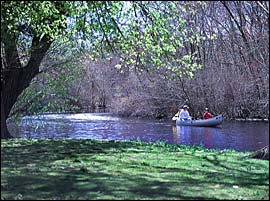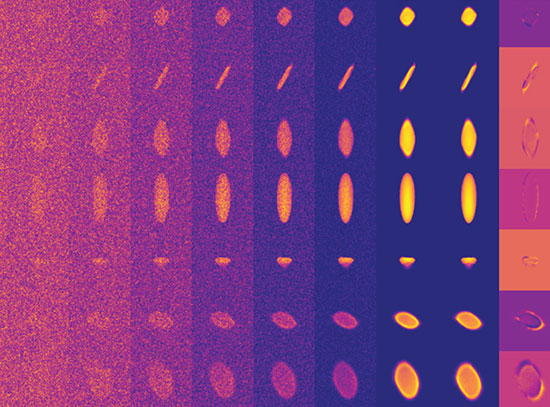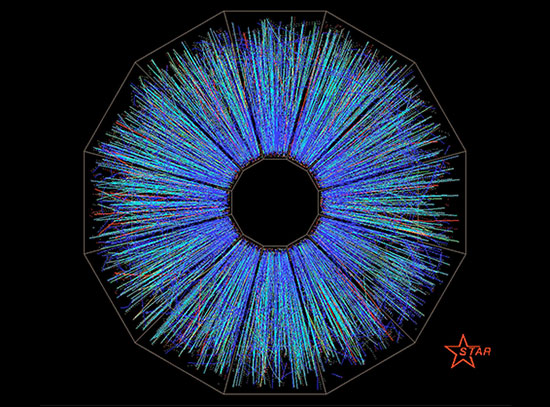Department of Energy, EPA, and N.Y. State Reach Agreement On Peconic River Cleanup
February 15, 2005
The following is a press release issued by the U.S. Department of Energy. DOE contact: John Carter, 631 344-5195.

The Peconic River
Upton, NY - The U.S. Department of Energy (DOE), the U.S. Environmental Protection Agency (EPA), and the NY. State Department of Environmental Conservation (NYSDEC) have agreed on a cleanup plan for contaminated sediment in sections of the Peconic River on the Brookhaven National Laboratory (BNL) site and extending into Suffolk County parkland. The agreement, reached after extensive regulator and public review and comment, allows the Energy Department to implement the selected remedy. It also marks an important milestone in DOE's plan to complete cleanup of the Laboratory site.
The remedy is detailed in a document called the "Final Operable Unit V Record Of Decision for Area of Concern 30 (Peconic River)." The document is available at the libraries listed below, and on the Brookhaven web site at http://www.bnl.gov/erd/peconic.html.
The Record of Decision (ROD) presents the selected remedial actions for contaminated sediments extending from BNL's sewage treatment plant to approximately 3.5 miles past the site boundary. The portion of the cleanup on Lab property, completed in September 2004, was conducted under an Action Memorandum finalized following public comment periods in 2003 and 2004. This Action Memorandum is included as Appendix A of the ROD. The portion of the cleanup off Laboratory property, including an estimated 9.1 acres within Suffolk County parkland, began after an access agreement with Suffolk County was finalized and is scheduled to be completed in the spring of 2005. The cleanup of the Peconic River beyond BNL property is being conducted under a separate Action Memorandum. This remedy sets a more stringent cleanup goal than for contaminated sediments on the Laboratory site and is included as Appendix B of the ROD.
The ROD agreement, which is supported by the Suffolk County Department of Health Services (SCDHS) and the New York State Department of Health (NYSDOH), follows extensive public participation activities held by the Department of Energy since 1994. The Department of Energy requested input from the community on the Peconic River investigation and potential cleanup approaches. These activities included dozens of briefings to area civic groups, public and private organizations, and the Laboratory's Community Advisory Council and Brookhaven Executive Round Table; more than a dozen round table and informational sessions with interested community residents; public comment periods on related cleanup documents; and informational mailings to and canvassing of homes in the Operable Unit V area. These events generated comments and concerns that have been made part of the public record. The ROD contains a Responsiveness Summary, which documents public comments on the proposed remedial actions, DOE responses to those comments, and changes made as a result of them.
Background
BNL has operated its sewage treatment plant since the Laboratory was established in 1947. Historical operations and disposal practices resulted in the discharge into the Peconic River of wastewater containing chemical and radiological contaminants, which were then deposited in the sediment. Regulations governing the plant have become more stringent through the years, and BNL has periodically upgraded the plant to comply with changing regulations and increase the removal of pollutants. Wastewater from Laboratory operations is processed and treated at the plant before being discharged into the Peconic River on BNL property, and is currently monitored at the discharge point and at several upstream and downstream locations.
Since 1994, DOE and BNL have conducted a detailed investigation of sediment, fish, plants, and water in on- and off-site portions of the Peconic River. Sampling indicates that there are elevated levels of mercury, polychlorinated biphenyls (PCBs), and other contaminants in sediments on and just downstream of the Laboratory property. Elevated levels of mercury and PCBs have also been detected in fish on the Laboratory property; elevated levels of mercury have been detected in fish off the Laboratory site. The New York State Department of Health has evaluated fish samples and determined that consumption within the State advisory guidelines for freshwater fish is acceptable.
Details of Selected Remedy
Under the selected remedy, six to 12 inches of sediment will be removed from areas where contaminants have been deposited. Sediment would also be removed from areas identified as preferential sources of methylmercury, the form of organic mercury found in the environment that accumulates in fish and human tissue. The selected remedy will protect human health and the environment by removing contaminated sediment and contributing to the reduction of mercury in fish tissue.
The off-site area targeted for cleanup lies within Suffolk County parkland. In order to give the County the greatest flexibility in terms of future use or development of the property, the remedy sets a more stringent cleanup target concentration than that for contaminated sediments on the Laboratory site. The $11.5 million project is expected to result in an estimated 92 percent reduction of mercury and 93 percent removal of PCBs in on- and off-site river sediment. Other co-located contaminants will also be removed.
The selected remedy also includes habitat restoration and long-term monitoring of surface water, sediment, and fish to evaluate cleanup effectiveness.
The cleanup will be accomplished using low-impact, conventional construction equipment. Excavated sediment will be shipped off site to a licensed disposal facility, river habitat will be restored as appropriate, and long-term monitoring will verify the effectiveness of the cleanup. The cleanup is proceeding under the guidance of DOE, EPA, and NYSDEC.
Based on the public comments received and subsequent discussions with the EPA, NYSDEC, NYSDOH, and SCDHS, two principal changes were made to the Peconic River wetland restoration process and are reflected in the Record of Decision:
- To the maximum extent possible, BNL will not bring in topsoil to replace removed sediment. Instead, sediment will be taken from designated "open water" areas of the river to complete the restoration process following confirmatory sampling.
- To the maximum extent possible, wetland plants used to restore sections of the Peconic River will be obtained from within the Peconic River itself.
A map showing the areas where sediment removal is planned, under way, or completed can be found at http://www.bnl.gov/erd/peconic.html .
The Final Operable Unit V Record Of Decision for Area of Concern 30 (Peconic River) is available at the Mastics-Moriches-Shirley public library, at the BNL library, and at the U.S. Environmental Protection Agency, Region II library in New York City. For further information, call John Carter, U.S. Department of Energy, at 631 344-5195, or Jen Clodius, Brookhaven National Laboratory, at 631 344-2489, or visit the website.
Environmental remediation at Brookhaven Lab is carried out under requirements of the federal Comprehensive Environmental Response, Compensation, and Liability Act of 1980. Past operations at the laboratory have resulted in soil and groundwater contamination. Remediation work is conducted under the framework of an interagency agreement among the U.S. Department of Energy, the U.S. Environmental Protection Agency and N.Y. State Department of Environmental Conservation. The Department of Energy owns the Brookhaven property, and oversees and funds the cleanup program.
2005-10277 | INT/EXT | Newsroom









